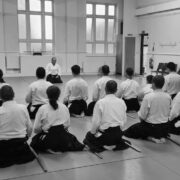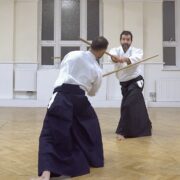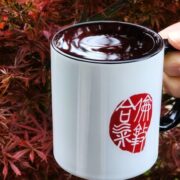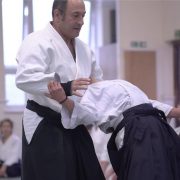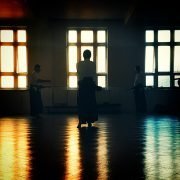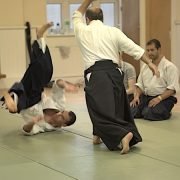AIKIDO SENSEI AND SEMPAI…
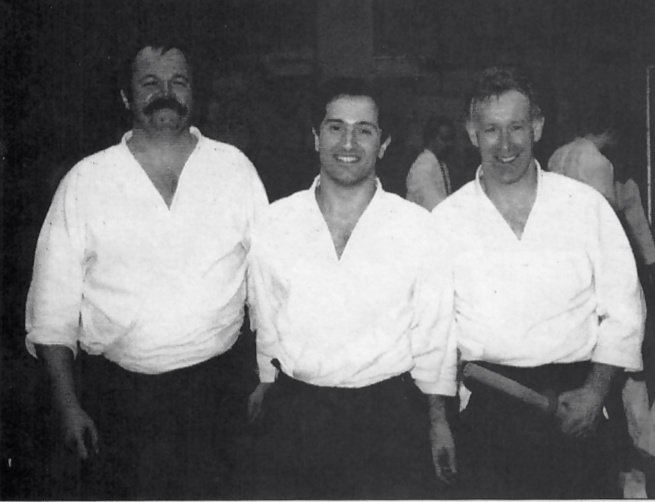

William Smith and Gordon Jones, along with Phillip Smith, 4th Dan, have built Cradley Dojo into a home from home for their students. A home that is willingly and frequently opened up for Aikidoka of all persuasions.
l feel that all of us who have been fortunate enough to have studied under Chiba Sensei have taken a little of his great spirit and technique and made it part of ourselves. There are many such Aikidoka of whom l could speak in this respect but time must limit me. So the chosen few wll be: Miss Dorothy Chen, Mr. Tony Cassells, Mr. Ismail Hasan and the late and much lamented Mr. George Girvan.
Dorothy, or ‘Dee’ Chen, is the Principal Instructor at London Aikikai, the Shin Meikan Aikido Dojo, and holds the rank of 5th Dan. Although diminutive in stature, Dee is more than capable of dealing with the most concerted of attackers, and does so with much grace under pressure. What Miss Chen lacks in body weight and aggression, she more than makes-up for in her acute sense of timing. Dee has faithfully followed Chiba Sensei’s Aikido for more than two decades, both in this country and in Japan. Without her endeavours and steadfast loyalty to her teacher, the face of the London Aikikai would be very different indeed. Despite being a naturally quiet and unassuming lady, Dee can create quite an inspiring presence in the dojo. She is also capable of exerting her authority with merely the raising of an eyebrow.
Dee Chen has, in my opinion, captured some of the essence of Chiba Sensei’s movement. That is, the very relaxed, yet dynamic tai sabaki that both draws an uke’s attack, and then envelops and controls it. This, for me, is displayed particularly well in her execution of suwari waza or kneeling/sitting techniques. In this she is able to show almost paradoxically, an economy and conciseness of movement with a boldness of application. Her use of ki musubi (contact) has a ‘stickiness’ that is reminiscent of Tai Chi Chuan. This is a technical aspect that adds much to the subtle quality of her Aikido.
Also teaching at Shin Mei Kan with Dee Chen are Steve Beecham, 4th Dan, a man very much influenced by both Chiba Sensei and Tamura Sensei, and that most reliable and modest of men, Mr. Eric Beake, 3rd Dan. Quite a line-up for the fortunate students of London Aikikai. Now this instructional team has been expanded and enhanced by the arrival of Mr. Ismail Hasan, 4th Dan, from Chiba Sensei’s dojo in San Diego, California.
Ismail began his Aikido training with the aforementioned Steve Beecham at his dojo in the Elephant and Castle area of South London in 1977. He progressed quickly, gaining shodan in 1981 from Steve’s brother, Alan Beecham, another of Chiba Sensei’s old students. Then in 1985 he took himself off to San Diego to become an uchi deshi to Chiba Sensei, and become a part of his Kenshusei (trainee instructor) programme. lsmail spent a rigorous three years apprenticeship and afterwards travelled throughout the U.S.A. training under various other Shihan. Ismail was founder of, and Chief Instructor to, the Santa Fe Aikikai. He has now returned to his native north London, where he plans to teach Aikido on a professional basis.
We first met at the 1988 Budo Sai in Sunderland where, with Yahe Solomon and Mike Holloway, he took falls for Chiba Sensei during an excellent demonstration. At that time he impressed me greatly as being a very competent and rigorous practitioner. Six years on, his Aikido, though no less dynamic, has a rounder and more controlled feeling. Taking ukemi (falls) for Ismail is quite an experience. One is moved very quickly over a large area of the dojo, and efficiently and effectively dispatched. His Aikido is one of the most relaxed styles that l have ever encountered, and his Budo attitude one of the sharpest. When l have taken ukemi for him, I feel almost as if I am receiving a private lesson in this most vital aspect of our art. This is due to the clarity of his movement, the control of his technique and, of course, his patience in teaching.
Ismail’s weapons training shows through into his tai jutsu (body art) technique very strongly, and his use of tegatana has a calm and confident effectiveness. Of course, his abilities are not limited to just handing it out. To see Ismail take ukemi for someone as dynamic as Chiba Sensei, or indeed Steve Beecham or Tony Cassells, is an unforgettable experience. His ukemi has a purposefulness and a vitality rarely achieved — it is the physical realisation of the concept of Zan Shin.
l have, on many occasions, seen Ismail partner Chiba Sensei for a weapons demonstration and, although obviously under great pressure from the ‘Boss’, he always appears calm, composed and in control of himself.
Chiba Sensei’s demonstrations have no pre-arranged form, he expects his assistants to react naturally to his techniques and his movements. This is, of course, an extension of their training and development, and must surely stretch their sense of awareness to almost breaking-point.
The courage to fully commit oneself to a bokken (sword) attack against Chiba Sensei is not easily found, and even more rarely is it retained. lsmail’s strength of character and dedication to the ideals and practicalities of Chiba’s Aikido marks him out as one of the future ‘greats’ of Aikido. Just remember where you read that, and who said it! .

